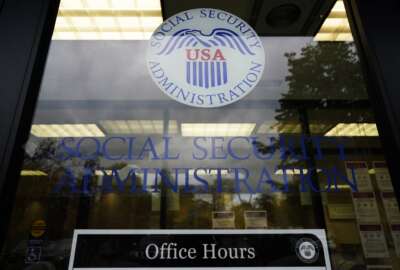Discussion: Information Sharing vs. Privacy
Finding the right balance between privacy and sharing is the subject of a Federal News Radio Discussion. Joining us are NARA\'s Hannah Bergman and CMS\'s William...
wfedstaff | June 3, 2015 4:15 pm
By Suzanne Kubota
Senior Internet Editor
FederalNewsRadio.com
Across federal agencies, you’ll find agreement that sharing information can make everyone smarter, improve mission delivery and boost transparency, but you’ll also find agreement that information-sharing increases the threat to privacy. Some recent events have intensified the need to balance sharing and privacy.
For example, OPM has announced plans for a database to track cost and quality of service under the Federal Employees Health Benefits Program. But the system would collect names, Social Security numbers, and employment details.
Finding the right balance between privacy and sharing is the subject of today’s Federal News Radio Discussion.
Joining us for the discussion were Hannah Bergman, Assistant General Counsel at the National Archives and Records Administration and William Saunders, Deputy Director for the Office of Information Services at the Centers for Medicare and Medicaid Services.
Here are some of the topics, questions and excerpts from the responses of the panel:
I. Guiding Principles and Weighing Interests
Saunders: “I think balance would be a good word.” Balancing the interests of privacy with the value of data for a lot purposes is a constant challenge for Saunders’ office. “It means we recognize that there is often a legitimate need to release information, but we try to make sure that it’s the minimal necessary information needed for that purpose.”
Bergman: NARA, said Bergman, has a “little bit of a different mission than most federal agencies.” NARA takes in records with the express intent of making them available to the public. On top of that, said Bergman, they need to “try and balance the privacy interests of the individuals whose information is in the records, our employees, in different ways and different contexts.” This forces the staff to think about privacy differently in archival records than operational files, “and we really try and do the right calculus on a case by case basis.”
Examples – Both Saunders and Bergman gave examples of the issues they could or have run up against. NARA has railroad retiree data. Of course that contains personally identifiable information, but since some of the data dates from the 1920’s, it also has important historical and genealogical significance. CMS has claims data from 45 million medicare beneficiaries. That needs to be protected, but at the same that data could be used to improve the quality of health care and reduce the costs.
Bergman: So weighing the interests is built into the process at NARA. “Any time records are received from a federal agency, and there’s an indication from the federal agency that those records are not appropriate for a wholesale public release, archivists go in and they might do a sampling of the records, they might do a page by page review – it would depend on where the records came from, the age of the records, and the level of description and detail we have from the federal agency.”
Saunders: CMS also uses standard processes for handling data, but flexibility has been built in. Requests outside the routine process can be looked at individually so a unique decision can be made.
II. Growing a Culture of Privacy in a Paper Based World
Bergman:“We’re working hard increasing our awareness of privacy particularly within operational records where employees are accustomed to working with archival records,” said Bergman. It can be the same type of information, but needs to be treated differently when it’s about current employees. And even within archival records, there’s a difference between records that have been digitized versus “when they’re only available on request in a room in College Park that you have to go ask for a particular box and have a box pulled.” So it’s “all about awareness and thinking about how privacy effects different situations and taking that into account.” Asked about pulling boxes of files, Bergman responded, “We’re a paper based agency. We’re a paper based federal government.”
Saunders: At CMS, privacy training is “a never ending process. It will never stop,” said Saunders. From initial training before getting a password to the computer to yearly training sessions, Saunders said the culture of privacy at CMS is constantly being updated.
Bergman: While they’re working toward a more electronic base, Bergman said NARA takes in paper records. Agencies’ official mechanism is paper. Until agencies put electronic records management systems in place “we’re in a print to file world”. Bergman said she’s “sad a little bit about that,” but has to deal with the current reality.
Saunders: The reality at CMS is handling billing and payments of more than a billion dollars a year. That would be impossible if paper had to be shuffled across desks. CMS feds “have to rely on electronic data.”
III. Governance
Saunders: – Data Governance Board handles new requests that set precedent. Saunders said CMS uses privacy principles to make the determinations whether to release data and the form the data will take. De-identified data can be released, he said, when it’s in the public interest.
Bergman: NARA processes requests every day, so they get more practice. If the file is closed to the public, NARA can do a page by page screening. And then if the requester needs more, a line by line screen can be done. “We don’t have the same sort of sensitive data that CMS does.” Bergman said NARA accepts about three percent of the federal government’s records with the intent of releasing it at some point. The agency wouldn’t even accept the information in the first place if it were the kind of information that could never be released, she explained.
IV. Transparency and data.gov
Bergman: With the advent of data.gov, many agencies have been challenged with figuring out how to produce usable datasets. Not so with NARA. Since archiving the Federal Register is big part of what NARA does, Bergman said they’ve been able to leverage that, “so that’s not the typical agency dataset.” NARA has “xml data files up there of all the Federal Register, the daily publication of the register, the presidential papers, the CFR (Code of Federal Regulations) so that’s really text based stuff that had been prepared previously in xml format for GPO (Government Printing Office) in their printing processes.”
Saunders: CMS, said Saunders, has posted “aggregate data, statistical data, or not-individual information on the data.gov site. In general, those were files that we already were producing, but they were available for purchase from someone and we would send out a cd after we received a payment.” That information is now available on data.gov, making that information more easily available at a lower price. Sauders said moving ahead, there is interest in being able to make individual data available on data.gov without identifiable information.
V. What’s Ahead
Saunders: “We know based on demographics of the U.S. population, the number of Medicare beneficiaries will grow very rapidly in the next couple of decades, so we’ll have a lot more beneficiaries and a lot more claims.” Saunders expects technology challenges when it comes to holding and managing all of the data, “but a lot of our concern is agility. The ability to get that data in, link it, massage it, produce reports and dashboards that help the government and the public identify fraud and abuse. Find ways to reduce costs of health care. And do that while not letting the current services and payment of claims stop in any way. That’s the big challenge.”
Bergman: “We do have a lava flow of information. We have it both in paper format and electronic format. One of the things that we’re working very hard on, we hope is fully operational by 2012, is the Electronic Records Archive and that’ll give us the ability to ingest electronic records directly from federal agencies where those records are permanent. That will help increase efficiencies in the processing and the review of those records and the ability to preserve them. With regard to the paper records, I think, we’re talking about how we digitize, where we put our resources in digitization partnerships where other private entities can digitize on our behalf and then make those records available and where we can say ‘okay, these are the records that there’s a lot of public interest in. There’s no national security concern. There’s no privacy concern and we’re going to digitize that now.’ And records where we have a lot of different concerns to weigh, we’re going to save that for later and weigh them as time passes. Those concerns may pass, may change, and then we’ll digitize that. We’re trying to prioritize (and) put our resources where we have them.”
You can hear the entire Federal News Radio Discussion by playing the audio at the top of this page.
Copyright © 2025 Federal News Network. All rights reserved. This website is not intended for users located within the European Economic Area.





